View in other NatureServe Network Field Guides
NatureServe
Montana
Utah
Wyoming
Idaho
Wisconsin
British Columbia
South Carolina
Yukon
California
New York
Banded Tigersnail - Anguispira kochi
Other Names:
Helix solitaria, Patula solitaria, Pyramidula solitaria, Helix kochi
Native Species
Global Rank:
G5
State Rank:
S5
Agency Status
USFWS:
USFS:
BLM:
External Links
General Description
A large shell, to 28 mm in diameter and 22 mm in height, heliciform with up to 6 whorls. Shell is opaque, pale or creamy brown, with a chitinous layer (periostracum) that may become lost with age and wear, the shell appearing grayish or chalky (sometimes difficult to separate from large Oreohelix). There is a pale spiral band above the rounded periphery that is bordered by two, and sometimes obscure, reddish-brown bands (in some shells these are visible inside the aperture); the undersurface lacks reddish bands (often present in Oreohelix in similar habitat). The shell is covered with a series of low axial riblets, including on the last half whorl of two protoconch (embryonic) whorls; umbilicus is deep, relatively narrow, and not obscured by the aperture lip, aperture round. Head and body are brownish, the tentacles darker (Hendricks 2012, Burke 2013). Internal anatomy is described by Pilsbry (1948).
The subspecies in Montana is Anguispira kochi occidentalis (see Burke 2013) but the vality of this designation has been questioned by some authorities.
Diagnostic Characteristics
Large size and aperture lacking a reflected lip distinguishes this shell from all others except some of the large Oreohelix (O. strigosa and O. subrudis) and Haplotrema. In live animals, the chitinous and opaque shell differs from the chalky gray or white shells of Oreohelix, although both have spiral bands (which may be faded or absent in dead and sun-bleached shells). The distinct rib-like sculpting on the embryonic whorls of Anguispira also help differentiate the two. Haplotrema has a flattened spire and a yellowish to olive-green color and no spiral banding.
Species Range
Montana Range
Range Descriptions
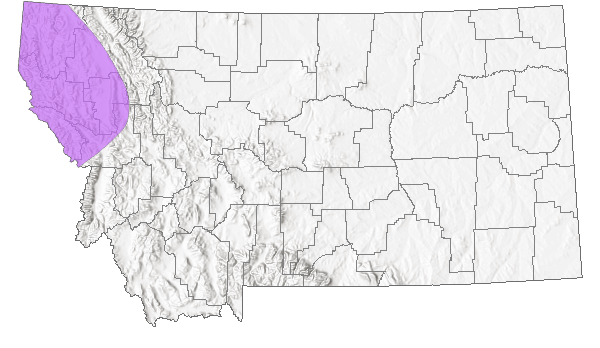
 Native
Native
Range Comments
North America from Lake Erie to Kentucky, Arkansas, and Missouri; in the west, southeastern British Columbia to Oregon east of the Cascades, east through Washington and Idaho to northwestern Montana. Western North American populations are disjunct from those in eastern North America. In Montana, reported from seven counties west of the Continental Divide: Flathead, Lake, Lincoln, Mineral, Missoula, Ravalli, Sanders. Elevation range is 693 to 1625 m (2275 to 5330 ft). May be abundant at some sites; as many as 55 were reported at one Lincoln County site in early October (Hendricks 2012).
Observations in Montana Natural Heritage Program Database
Number of Observations: 117
(Click on the following maps and charts to see full sized version)
Map Help and Descriptions
Relative Density
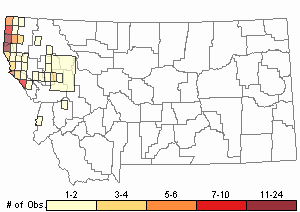
Recency
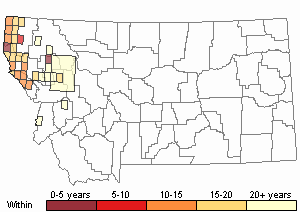
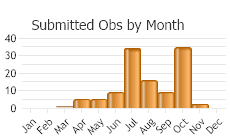
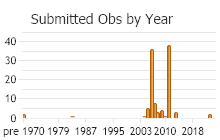
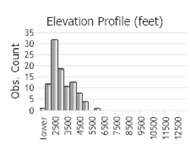 (Observations spanning multiple months or years are excluded from time charts)
(Observations spanning multiple months or years are excluded from time charts)
Habitat
Mostly in mesic mixed conifer forest, typically near water such as stream-side riparian, and seeps. Canopy species include western redcedar, western hemlock, Engelmann spruce, Douglas-fir, grand fir, western larch, lodgepole pine, black cottonwood and paper birch, and a secondary canopy including alder, dogwood and mountain maple. Found most often under woody debris or rocks in leaf litter and duff (Hendricks 2012).
Stewardship Responsibility
References
- Literature Cited AboveLegend:
 View Online Publication
View Online Publication Burke, T. E. 2013. Land snails and slugs of the Pacific Northwest. Corvallis, OR: Oregon State University Press. 344 p.
Burke, T. E. 2013. Land snails and slugs of the Pacific Northwest. Corvallis, OR: Oregon State University Press. 344 p. Hendricks, P. 2012. A Guide to the Land Snails and Slugs of Montana. A report to the U.S. Forest Service - Region 1. Montana Natural Heritage Program, Helena, MT. vii + 187 pp. plus appendices.
Hendricks, P. 2012. A Guide to the Land Snails and Slugs of Montana. A report to the U.S. Forest Service - Region 1. Montana Natural Heritage Program, Helena, MT. vii + 187 pp. plus appendices. Pilsbry, H.A. 1948. Land Mollusca of North America (north of Mexico), Volume II Part 2. The Academy of Natural Sciences of Philadelphia Monograph Number 2(2): 521-1113.
Pilsbry, H.A. 1948. Land Mollusca of North America (north of Mexico), Volume II Part 2. The Academy of Natural Sciences of Philadelphia Monograph Number 2(2): 521-1113.
- Additional ReferencesLegend:
 View Online Publication
View Online Publication
Do you know of a citation we're missing? Bland, T. and J.G. Cooper. 1861. Notice of land and freshwater shells collected by Dr. J.G. Cooper in the Rocky Mountains, etc, in 1860. Annals of the Lyceum of Natural History of New York 7:362-370.
Bland, T. and J.G. Cooper. 1861. Notice of land and freshwater shells collected by Dr. J.G. Cooper in the Rocky Mountains, etc, in 1860. Annals of the Lyceum of Natural History of New York 7:362-370. Elrod, M.J. 1902. A biological reconnoissance in the vicinity of Flathead Lake. Bulletin of the University of Montana Number, Biological Series 10(3):89-182.
Elrod, M.J. 1902. A biological reconnoissance in the vicinity of Flathead Lake. Bulletin of the University of Montana Number, Biological Series 10(3):89-182. Forsyth, R.G. 2004. Land snails of British Columbia. Royal British Columbia Museum: Victoria, British Columbia, Canada. 188 pp.
Forsyth, R.G. 2004. Land snails of British Columbia. Royal British Columbia Museum: Victoria, British Columbia, Canada. 188 pp. Frest, T.J. and E.J. Johannes. 2001. An annotated checklist of Idaho land and freshwater mollusks. Journal of the Idaho Academy of Science 36(2):1-51.
Frest, T.J. and E.J. Johannes. 2001. An annotated checklist of Idaho land and freshwater mollusks. Journal of the Idaho Academy of Science 36(2):1-51. Hendricks, P. 2005. Surveys for animal species of concern in northwestern Montana. Unpublished report to the Montana Department of Fish, Wildlife & Parks, Montana Natural Heritage Program, Helena, Montana, May 2005. 53 p.
Hendricks, P. 2005. Surveys for animal species of concern in northwestern Montana. Unpublished report to the Montana Department of Fish, Wildlife & Parks, Montana Natural Heritage Program, Helena, Montana, May 2005. 53 p. Smith, A.G. 1943. Mollusks of the Clearwater Mountains, Idaho. Proceedings of the California Academy of Sciences, fourth series, 23:537-554.
Smith, A.G. 1943. Mollusks of the Clearwater Mountains, Idaho. Proceedings of the California Academy of Sciences, fourth series, 23:537-554. Vanatta, E.G. 1914. Montana shells. Proceedings of the Academy of Natural Sciences of Philadelphia 66:367-371.
Vanatta, E.G. 1914. Montana shells. Proceedings of the Academy of Natural Sciences of Philadelphia 66:367-371.
- Web Search Engines for Articles on "Banded Tigersnail"
- Additional Sources of Information Related to "Snails / Slugs"





